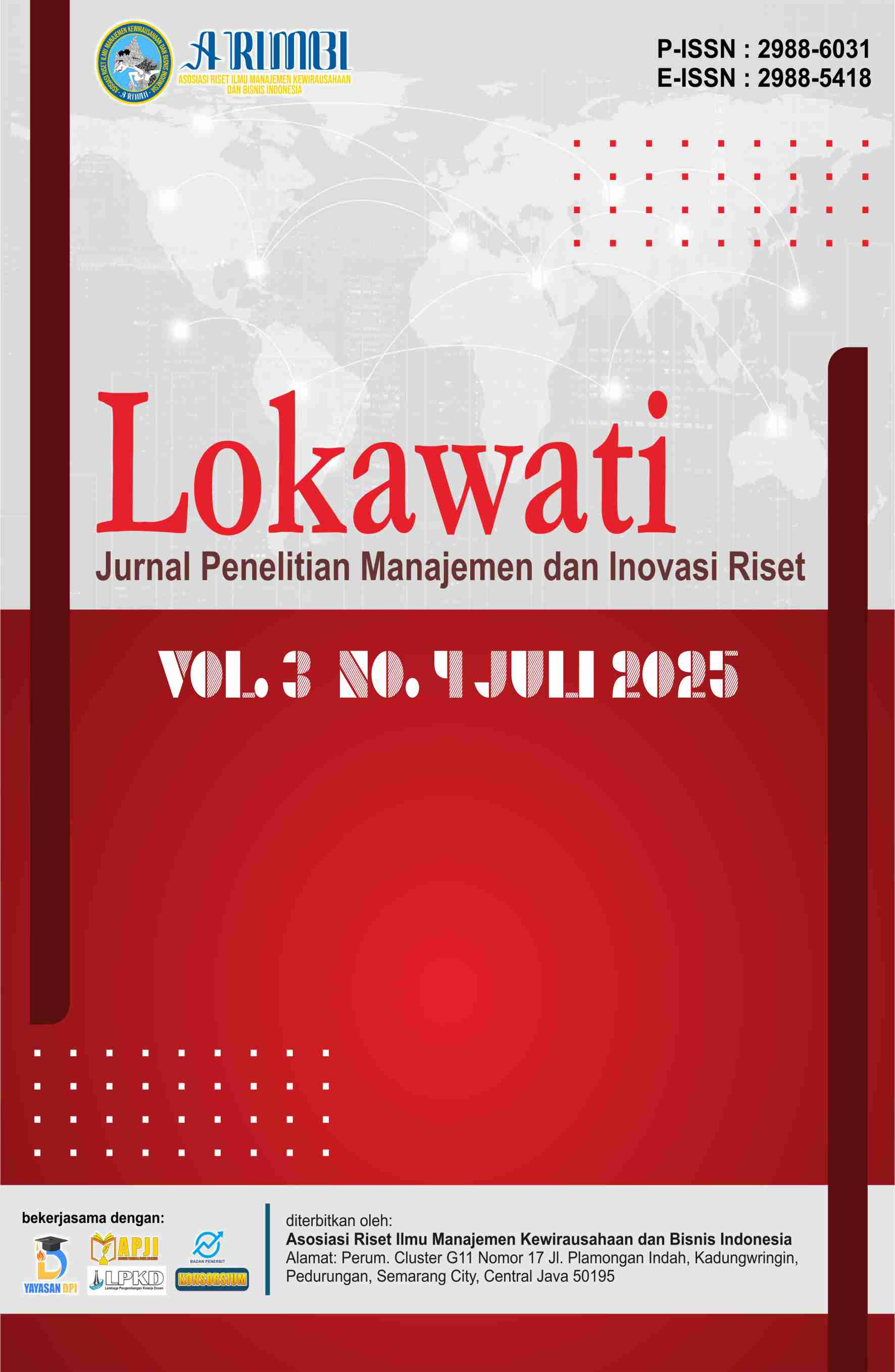Analisis Work-Life Balance pada Karyawan Non-Managerial Divisi Human Capital & General Affairs (HCGA) PT XYZ
DOI:
https://doi.org/10.61132/lokawati.v3i4.2008Keywords:
balance, employees, HCGA division, personal life, work-life balance, work worldAbstract
Work-life balance is a condition where an individual is able to maintain a balance between the world of work and personal life in a sustainable manner. This balance is something that is expected by every employee, including non-managerial employees of the HCGA division of PT XYZ. The main objective of this study is to determine the achievement of employee work-life balance as reviewed from three aspects, namely time balance, involvement balance, and satisfaction balance. In addition, this study also identifies factors that support and inhibit the achievement of work-life balance in employees. This study uses a qualitative descriptive approach, namely by describing and analyzing the problems that arise. Qualitative research is based on primary data and secondary data. Primary data in this study were obtained by conducting observations, interviews, and documentation, while secondary data were obtained through books, previous research, and articles related to the research. The results of the study indicate that not all employees are able to achieve optimal work-life balance. Some employees, especially those from the recruitment and general affairs departments, feel that they have a good work-life balance thanks to work flexibility and the ability to manage time. However, employees from the people development and administration departments of HCGA actually experience difficulties due to excessive workload, additional tasks outside of their job descriptions, and lack of team management from superiors. The support of coworkers who help each other and create a supportive work environment is one of the main supporting factors in achieving work-life balance. On the other hand, work pressure outside of working hours and ineffective communication are obstacles that are often faced. This study only uses one variable so that it cannot fully describe the relationship with other aspects such as work stress or job satisfaction. Therefore, further research is recommended to explore more variables in order to provide a more comprehensive understanding of work-life balance in the work environment.
Downloads
References
Ariawaty, R. R., & Cahyani, M. D. (2019). Pengaruh Employee Engagement Terhadap Work-Life Balance Karyawan. Jurnal Bisnis Dan Manajemen, 13(2). 97. https://doi.org/10.19184/bisma.v13i2.9864.
Exacta, E. A., Komariah, K., & Saori, S. (2022). Analisis Burnout Dan Work Life Balance Terhadap Turnover Intention Di Masa Pandemi Covid-19. Procuratio: Jurnal Ilmiah Manajemen, 10(3), 288-302. https://doi.org/10.35145/procuratio.v10i3.2092.
Fadilah, M. I. (2024). Work Life Balance: Studi Fenomenologi Pada Lembaga Pendidikan. NUSRA: Jurnal Penelitian dan Ilmu Pendidikan, 5(1), 114-123. https://doi.org/10.55681/nusra.v5i1.1865.
Fadli, M. R. (2021). Memahami desain metode penelitian kualitatif. Humanika, 21(1), 33–54. https://doi.org/10.21831/hum.v21i1.38075.
Hedianti, D. A. (2022). Analisis Work Life Balance Pada Freelancer. Ekonis: Jurnal Ekonomi dan Bisnis, 24(1), 44-48. http://dx.doi.org/10.30811/ekonis.v24i1.3241.
Hendra, D., & Artha, B. (2023). Work-Life Balance: Suatu Studi Literatur. Innovative: Journal Of Social Science Research, 3(3), 11320-11330. Retrieved from https://j-innovative.org/index.php/Innovative/article/view/3636.
Mardiani, I. N., & Widiyanto, A. (2021). Pengaruh work-life balance, Lingkungan Kerja dan Kompensasi terhadap Kinerja karyawan PT Gunanusa Eramandiri. Jesya (Jurnal Ekonomi dan Ekonomi Syariah), 4(2), 985-993. https://doi.org/https://doi.org/10.36778/jesya.v4i2.456.
Nurhabiba, M. (2020). Social support terhadap work-life balance pada karyawan. Cognicia, 8(2), 277–295. https://doi.org/10.22219/cognicia.v8i2.13532.
Nurshoimah, T., Nurweni, H., & Hartati, R. (2023). Pengaruh Work Life Balance, Work Overload dan Burnout terhadap Kinerja Pegawai Dinas Kesehatan Kabupaten Kulon Progo. Cakrawangsa Bisnis: Jurnal Ilmiah Mahasiswa, 4(1), 27. http://dx.doi.org/10.35917/cb.v4i1.407.
Pratiwi, I. W. (2021). Work Life Balanced Pada Wanita Karir Yang Telah Berkeluarga. Jurnal Psikologi Pendidikan dan Pengembangan SDM, 9(2), 52-65. https://doi.org/10.37721/psi.v9i2.755.
Ridawati, D. R. (2022). Pengaruh Flexible Working Arrangement terhadap Work-Life Balance Pegawai pada Masa Pandemi COVID-19 (Studi di Dinas Kependudukan dan Pencatatan Sipil Kabupaten Lumajang). https://repository.unej.ac.id/bitstream/handle/123456789/110.
Wicaksana, S. A., & Suryadi, S. (2020). Identifikasi Dimensi-Dimensi Work-life Balance pada Karyawan Generasi Milenial di Sektor Perbankan. Widya Cipta: Jurnal Sekretari dan Manajemen, 4(2), 137-143. https://doi.org/10.31294/widyacipta. v4i2.8432.
Wirawan, S. A. (2023). Hubungan Antara Work Life Balance dengan Kepuasan Kerja Pada Karyawan Sales. MANASA, 12(1), 76-87. https://doi.org/10.25170/manasa.v12i1.4484.
Wulansari, O. D. (2023). Narrative Literature Review: Faktor-Faktor yang Mempengaruhi Work-Life Balance. Psychopreneur Journal, 7(1), 15–28. https://doi.org/10.37715/psy.v7i1.3404.
Downloads
Published
How to Cite
Issue
Section
License
Copyright (c) 2024 Lokawati : Jurnal Penelitian Manajemen dan Inovasi Riset

This work is licensed under a Creative Commons Attribution-ShareAlike 4.0 International License.






